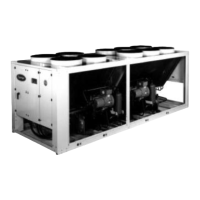5
Any manipulation (opening or closing) of a shut-off
valve must be carried out by a qualified and authorised
engineer. These procedures must be carried out with the
unit shut-down.
NOTE: The unit must never be left shut down with the
liquid line valve closed, as liquid refrigerant can be trapped
between this valve and the expansion device. (This valve
is situated on the liquid line before the filter drier box.)
During any handling, maintenance and service operations
the engineers working on the unit must be equipped with
safety gloves, glasses, shoes and protective clothing.
Never work on a unit that is still energized.
Never work on any of the electrical components, until the
general power supply to the unit has been cut using the
disconnect switch(es) in the control box(es).
If any maintenance operations are carried out on the unit,
lock the power supply circuit in the open position ahead
of the machine.
If the work is interrupted, always ensure that all circuits
are still deenergized before resuming the work.
ATTENTION: Even if the compressor motors have been
switched off, the power circuit remains energized, unless
the unit or circuit disconnect switch is open. Refer to the
wiring diagram for further details. Attach appropriate
safety labels.
Operating checks:
IMPORTANT INFORMATION REGARDING THE
REFRIGERANT USED:
• This product contains fluorinated greenhouse gas
covered by the Kyoto protocol.
Refrigerant type: R-134a
Global Warming Potential (GWP): 1300
Periodic inspections for refrigerant leaks may be
required depending on European or local legislation.
Please contact your local dealer for more information.
• During the life-time of the system, inspection and tests
must be carried out in accordance with national
regulations.
The information on operating inspections given in annex
C of standard EN278-2 can be used if no similar criteria
exist in the national regulations.
Safety device checks (annex C6 – EN 378-2):
• The safety devices must be checked on site once a year
for safety devices (high-pressure switches), and every
five years for external overpressure devices (safety
valves).
• Check manual “30GX/30HXC Pro-Dialog Plus
control” for a detailed explanation of the high-
pressure switch test method.
If the machine operates in a corrosive environment, inspect
the protection devices more frequently.
Regularly carry out leak tests and immediately repair
any leaks.
All installation parts must be maintained by the personnel in
charge, in order to avoid material deterioration and injuries
to people. Faults and leaks must be repaired immediately.
The authorized technician must have the responsibility to
repair the fault immediately. Each time repairs have been
carried out to the unit, the operation of the safety devices
must be re-checked.
If a leak occurs or if the refrigerant becomes contaminated
(e.g. by a short circuit in a motor) remove the complete
charge using a recovery unit and store the refrigerant in
mobile containers.
Repair the leak detected and recharge the circuit with the
total R-134a charge, as indicated on the unit name plate.
Certain parts of the circuit can be isolated. If leaks occur in
these sections it is possible to top up the refrigerant charge.
Refer to chapter 11.2 ‘Refrigerant charging - adding charge’.
Only charge liquid refrigerant R-134a at the liquid line.
Ensure that you are using the correct refrigerant type
before recharging the unit.
Charging any refrigerant other than the original charge
type (R-134a) will impair machine operation and can even
lead to a destruction of the compressors. The compressors
operating with this refrigerant type are lubricated with a
synthetic polyolester oil.
Do not use oxygen to purge lines or to pressurize a machine
for any purpose. Oxygen gas reacts violently with oil,
grease, and other common substances.
Never exceed the specified maximum operating pressures.
Verify the allowable maximum high- and low-side test
pressures by checking the instructions in this manual and
the pressures given on the unit name plate.
Do not use air for leak testing. Use only refrigerant or dry
nitrogen.
Do not unweld or flamecut the refrigerant lines or any
refrigerant circuit component until all refrigerant (liquid
and vapour) has been removed from chiller. Traces of
vapour should be displaced with dry air nitrogen. Refrige-
rant in contact with an open flame produces toxic gases.
The necessary protection equipment must be available,
and appropriate fire extinguishers for the system and the
refrigerant type used must be within easy reach.
Do not siphon refrigerant.

